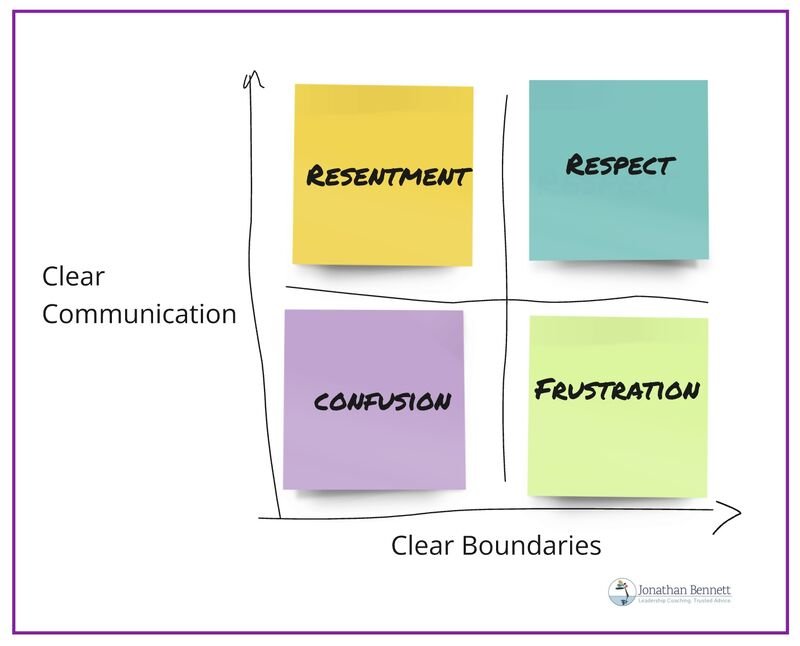Boundaries (and the Art of Saying Why)
Fig 1: Clear boundaries that go unsaid and only live in your head, will cause you private frustration. If you communicate your boundaries well, but then don’t stick to them with actions and consequences, then you’ll become resentful.
We can't just "set and forget" boundaries. If we don't communicate them clearly and often, others can't reliably meet our needs.
But I get it.
The whole concept of setting boundaries can often feel like a luxury—as opposed to a necessity.
However, what I see in my practice every day is that the ability to establish and maintain boundaries is an essential skill for any leader who hopes to thrive.
Let me get specific.
When we’re on the phone in a session, and you blame others, tell me you’re stressed, conflict-avoidant, or struggling with a colleague, I am probably going to ask about your boundaries. I tend to start there. Why?
Because what’s going on there tells me a lot about you and your needs.
Boundaries serve as a framework for how we interact with our colleagues, manage our time, and prioritize our work.
Think of them as invisible lines that delineate our professional and personal lives, ensuring that we don't burn out or compromise our well being for the sake of our careers, our businesses, or our longterm goals.
So, when we, as leaders, set and maintain boundaries, we create a culture of respect and efficiency that benefits everyone in the organization—including ourselves.
The Consequences of Poor Boundaries for me
What’s true for you is true for me. Without clear boundaries, I find myself overextended, distracted, and even dysregulated. If I don’t catch it, it can lead to decreased productivity and increased stress.
How does it show up for you?
Poor boundaries also have a negative effect on those around you. It sends a message to the team that it's acceptable to ignore limits, leading to a negative work environment.
But, when you set and maintain boundaries for yourself, you train those around you to respect your time, plans, and needs.
Communicate Clearly and Often (And Say WHY they Matter)
Setting boundaries is not a “one and done” task. It's an ongoing process that requires clear and consistent communication.
I make it a point to regularly discuss my boundaries with my clients, board colleagues, and others I work with. Yes, sometimes I address it head-on—explicitly telling folks what I know I need and asking them what they need in return. Other times, it’s more subtle. I use questions and curiosity to draw out and jointly set boundaries with those in my orbit. It’s context-dependent for sure. The key, I’ve found, is to be honest with yourself first and consistent and intentional with those in your work life.
It’s also essential to “say the quite part out loud.” Take the time to explain why you need these boundaries, how they are important for you, and the negative consequences for you (and your work) when they are ignored. Helping people with your reasoning and rationale is kind, it’ll draw them in and help them help you.
Practical Steps to Setting Boundaries
1. Identify Your Limits: The first step in setting boundaries is to understand and accept your own limits. What are your non-negotiables, and why? What tasks or activities drain your energy? Knowing these will help you set realistic and effective boundaries.
2. Communicate Your Boundaries: Once you've identified your limits, communicate them clearly. Use specific language and provide examples to ensure there is no ambiguity. Say why they are needed.
3. Be Consistent: Consistency is crucial when it comes to maintaining boundaries. If you allow exceptions for some folks some of the time, you risk undermining your own rules. Stick to your boundaries and be consistent.
4. Encourage Mutual Respect: This goes both ways. Encourage your team to set their own boundaries and respect those of others. This creates a safe culture of mutual respect and trust.
5. Review and Adjust: Boundaries are not set in stone. People change. Contexts evolve. Regularly review and adjust your boundaries as needed. Be sure to communicate how and why your needs have shifted. Bring folks along and check in with them—how have their needs changed since you last talked?
The Virtuous Cycle of Boundaries 🔄
Setting and maintaining boundaries creates a virtuous cycle. When I respect my own, I am better able to meet my responsibilities and deadlines. This, in turn, sets a positive example for others, encouraging them to respect their own boundaries and those of their colleagues.
In my advisory work, when I see safe, healthy workplace cultures, I always find people there with clear and consistent boundaries that are accepted and respected.
Final word: boundaries are not a luxury—they are a necessity for good leadership. So, take the time to set and maintain them with those around you.
Need a little help with boundaries? Reach out.

